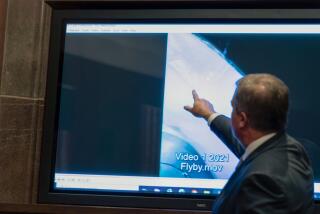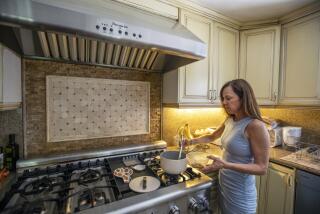Tomato Seeds From Space Grow Into Flap : Science: NASA memo says seeds retrieved from satellite and distributed to schools around the country for experiments were exposed to cosmic radiation. It is believed there is a slight danger of mutations.
- Share via
An internal memo written by a NASA contractor warns that shuttle-borne tomato seeds planted nationwide by science students as part of a space agency experiment were exposed to cosmic radiation that could produce poisonous tomatoes.
While the unsigned memo, obtained by The Times, describes the danger as “remote,” it reports that the research director at Park Seed Co., which supplied NASA with the seeds, “seemed to favor against” eating the tomatoes.
No such warning, however, was included in educational materials or press releases sent to 180,000 teachers participating in the experiment, designed to rouse interest in science and space by providing 4 million students with an opportunity to study the effects of long-term space exposure on living tissue.
Asked about the seed program Thursday, NASA officials conceded there was an “infinitesimal” risk of toxic tomatoes, but they defended the decision not to warn teachers and students about consuming the experimental harvest. They said that as part of a scientific experiment, the tomatoes should not be eaten anyway.
The two-page memo--described by Frank Owens, deputy director of NASA’s educational affairs division, as “not an official NASA memo”--was sent apparently by mistake about two weeks ago to the NASA/JPL Teaching Resource Center in La Crescenta. The facility has been distributing the seeds and educational materials to participants in Southern California.
It was written by Nelson Ehrlich, associate director of the aerospace education services program at Oklahoma State University, which oversees NASA’s school programs.
“There is a remote possibility,” the memo says, “that radiation-caused mutations could cause the plants to produce toxic fruit.”
Radiation levels in space are higher than those on Earth, and scientists said it is theoretically possible that the seeds’ genetic makeup could have been altered and could create toxic fruit.
Ehrlich said Thursday that the memo was intended to provide “background information” for about 30 employees who visit schools across the country to make presentations about NASA and the space program. He said it was intended to help them answer questions about the tomato seeds.
“It was not meant to get out like it has gotten out,” Ehrlich said. “Even though the possibility is there, it is extremely remote. People shouldn’t have fears.”
Nonetheless, at least one Los Angeles participant in the experiment has decided to drop out because of the warning, and an official from the urban gardening program at the University of California Cooperative Extension in Los Angeles said she is recommending that elementary schools not become involved.
“I think it is a great project, but I can’t recommend it to any more schools just for safety reasons,” said Rachel Mabie, youth gardening coordinator for the Common Ground Garden Program. “Kids will eat anything that they grow.”
NASA’S Space Exposed Experiment Developed for Students(SEEDS) was one of 57 experiments carried aboard an 11-ton satellite launched six years ago by the space shuttle Challenger. About 12.5 million seeds were stored on board in five sealed aluminum canisters. The satellite was retrieved in January by the shuttle Columbia and the seeds began to be placed in circulation.
Participants in the program--ranging from elementary school pupils to college students--have been given “space-exposed” seeds as well as control seeds that never left Earth. The students are to grow both sets of seeds and monitor any differences, reporting back to NASA in June.
Gilbert Yanow, who heads the JPL center’s education outreach programs, said his office distributed the memo to only a “handful” of teachers who picked up their seeds and materials in La Crescenta. Most teachers in the Los Angeles area received their seeds and information by mail from NASA and Park Seed.
“I will probably be one of the first to eat them,” said Yanow, who is growing a packet of seeds himself. “But I don’t think I should hide anything from the teachers. Anything I get from headquarters, I should pass on.”
Officials at the Barnsdall Art Park, a Hollywood arts and recreation center run by the city of Los Angeles, decided to drop out of the experiment after picking up a copy of the memo this week. A special planting ceremony was scheduled Wednesday for children in an after-school education class and their parents, but officials substituted potted seedlings for the space seeds at the last minute.
“I just couldn’t believe that these would be handed out to kids to grow with such a potential for catastrophe,” said Richard Stretz, educational coordinator at the park. “I immediately went out during my lunch hour and bought 12 different kinds of potted tomatoes and we planted those instead.”
Not all teachers expressed alarm when informed of the situation. In the San Joaquin Valley, the heart of California’s tomato industry, teachers said they were not concerned about coming across a mutant tomato. Ken Selee, a sixth-grade teacher in Turlock, said students there have been cultivating the space seeds since March 12, and many of them will take the small plants home during the next few weeks.
“We are going to have a community salad and all kinds of stuff when we get this ready,” Selee said. “Not only are we going to eat them, but we have made a contract with a large commercial seed company to dry some of our fruit so we will have second- and third-generation seeds.”
A biotechnology expert with the U.S. Department of Agriculture in Washington said NASA had sought advice from his agency and the Food and Drug Administration about the safety of the seed experiment.
Alvin L. Young, director of the department’s office of agricultural biotechnology, said both agencies assured NASA that the experiment “should present no food safety risks.”
Young said he recommended nonetheless that the space agency tell teachers and students not to eat the tomatoes because “there are risks in everything we do.”
NASA rejected the idea for fear that it “would put out the wrong signal” by making people “think there is something wrong with the tomatoes,” Young said. In fact, a teacher’s guide explicitly states that “the space-exposed seeds do not pose any health hazard.”
Jim Alston, director of research at South Carolina-based Park Seed, said that the idea of circulating a warning had been considered and rejected.
“If you say don’t eat them, it is going to scare people,” Alston said. “We decided if we state this is a scientific experiment, then that is that.”
NASA’s Owens, who said he was unaware that a warning had been contemplated, characterized the budding reaction to the memorandum as “a little bit of hysteria.”
“It is understandable when people think of radioactive material, with Three Mile Island and all that,” he said. “But in this case NASA has gone to all extents possible to determine that this is a safe experiment.”
He said the whole issue of eating the tomatoes should be moot: “As a person conducting research, I would not experiment with eating the fruit. I think that is just self-evident.”
Alston said Thursday that he intends to eat the tomatoes anyway because the chance of biting into a poisonous one is “so remote it is almost impossible.”
He would not go so far, however, as to recommend that others eat them.
“There is that far-fetched possibility that some kind of mutation has changed something in the genetic material . . . of the fruit,” he said. “Because of the visibility of this thing, somebody out there is going to be looking for an easy buck: ‘I ate this tomato and got sick, and I’m going to sue for a million dollars.’ For that reason, we are not recommending that they be eaten.”
Vincent Rubatzky, a vegetable specialist at UC Davis, said placing the seeds in space increases the likelihood of radiation-induced mutations because the seeds no longer have the protection of the Earth’s atmosphere. He said, however, that the odds are “one in several million” that cosmic radiation would cause a mutation, and even less likely that it would cause a toxic one.
“Even if it did, it would be very easily determined,” Rubatzky said. “If you try it, and it tastes like skunk meat, it would be very evident.”
Free-lance writer Teddy Colbert contributed to this story.






